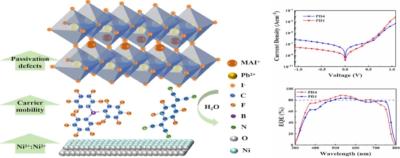Interface engineering is widely used to enhance the efficiency and stability of photodetectors (PDs). Researchers from China's Guangxi University have explained that although fluorine-containing materials are ideal for interface modification, they are seldom used at the NiOx/perovskite interface. Their recent paper reports on the use of Tris(pentafluorophenyl)borane (BCF) and 2,3,5,6-tetrafluoro-7,7,8,8- tetracyanoquinodimethane (F4-TCNQ)-modified NiOx HTL to achieve high-efficiency and high-stability PDs.
This work shows that BCF and F4-TCNQ interact to provide better doping ability, form Lewis adducts with Pb2+, and enhance the crystallinity of their perovskites. Interaction with nickel oxide optimizes the Ni3+/Ni2+ ratio, thus improving conductivity and charge transport capability. The F4-TCNQ:BCF modification effectively reduces interface defects, improves carrier mobility, and enhances both the performance and stability of PDs in ambient air.
The detector fabricated by the team achieved a maximum EQE value of 89.4%, a dark current density of 1.51 × 10−10A cm−2, a detectivity of 6.33 × 1013 Jones, and a LDR of 133.4 dB.
Additionally, the interfacially modified device maintained over 90% of its initial performance after one month of storage in ambient air.
The team's results highlight the importance of F4-TCNQ:BCF interface modification and provide a reference for the further research and development of perovskite devices.


